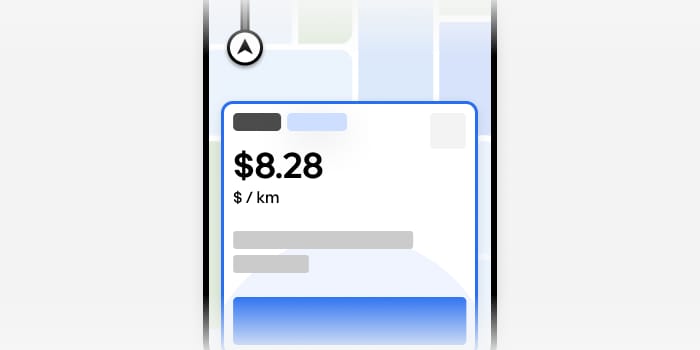
In a time when companies with complex transportation needs are searching for innovative ways to deliver great customer experiences, Ryder continues to depend on our solutions to successfully meet this demand.
Today, Ryder has announced that it has facilitated more than 100,000 rides with Uber for Business. By integrating directly with our API (application programming interface), Ryder can request, manage, and pay monthly for rides. The seamless integration helps Ryder enhance their employee and customer experience at scale.
Partnering to pave the way to efficiency
A few years ago, Rich Mohr, Chief Technology Officer of Ryder Fleet Management Solutions, was wrestling with several customer-experience and group-wide efficiencies facing his organization. After careful analysis, it became clear that many hours were lost in vehicle transport. The team then prioritized productivity enhancements for transportation.
At the time, if a vehicle transport driver or technician needed to get to a Ryder or customer location, either a second employee had to leave the facility to drive them or a loaner vehicle was provided. This effectively doubled the miles required to make a rental vehicle delivery. The same applied if a Ryder vehicle broke down and roadside assistance was required. After considering the options, Mohr connected with Uber to see how we could help tackle his organization’s unique challenges.
Seamlessly connecting Ryder customers with vehicles
The Uber for Business team spent hours mapping Ryder’s workflow and transportation-related disruptions. Based on Uber’s recommendations, Ryder rolled out Uber for Business to select personnel at its 800 rental locations in the US and Canada. This enabled the Ryder staff to request and manage rides through a web-based dashboard and pay through one monthly bill. They immediately saw savings on the toll and fuel costs they incurred while dropping off or picking up customers.
“Our customers mostly wanted to bring their truck in for service and get a ride back, not a replacement vehicle,” says Mohr. “Even though replacement vehicles were a hassle, our staff had to offer them because driving customers home meant one less person on-site. If they did provide a ride, it wasn’t the best use of their time.”
Deeper integration provides ride-level data
After the initial success of offering rides with Uber as a service to their customers, Mohr and his team wanted to expand the service to more customers and empower all of the rental location employees to use it. This required a deeper, API-level integration with Ryder’s legacy systems such as billing and single sign-on (SSO) required for security, authentication, and scaling purposes.
“We had to get the accounting side of this figured out so that our data from Uber could properly flow into our invoicing and CRM systems,” says Mohr. “The SSO integration was particularly important given it’s compliant with our HR protocols and ensures that employees can get access to Uber to request rides as soon as they come on board—and have it removed as soon as they leave.”
The same API integration they use for regular rides lets Ryder employees request rides for themselves. Uber’s API pulls the correct employee number from the SAP payroll system and ensures that the proper Ryder location and department gets billed.
Tangible results
Since the partnership’s inception in 2017, rental, service, and maintenance managers at Ryder in the United States and Canada have used Uber for Business to access transportation for drivers and technicians to and from both Ryder and customer locations, resulting in less customer downtime and a predictable cost-per-mile structure.
“Businesses thrive on accurate reports. By integrating our systems with Uber’s API, we are able to probe costs by employee, region, vehicle lease, and many other variables. Examining the data in so many ways helps us get a deep understanding of where all of these funds are going,” says Mohr. “Now that we understand how these dollars are being spent, we can be much more proactive with our business.”
Through the API integration, Ryder has gained critical insights—such as the average time and distance of each ride—enabling the company to better allocate staff time and resources and be more flexible in terms of meeting customer demands. Metrics the team gathered include:
- 100,000+ rides with Uber since 2017
- Total cost-per-unit-reduction of 4.7% to date
- Average trip length of 21 miles and 30 minutes
“This API integration makes our application as flexible and powerful as the application services Uber offers, which can now be consumed from within the Ryder business process,” says Ramesh Sundaresan, Ryder Vice President and Divisional CIO.
Overall benefits include:
- Improved productivity and time savings
- Less time away from core job functions for Ryder staff
- Increased customer satisfaction
- Ability to plan staff time and resources accordingly
Rich Mohr“Teaming with Uber has helped us to drive efficiencies, analyze costs, increase employee productivity, and save on costs. Best of all, our customer satisfaction rates are higher than ever before.”
Chief Technology Officer of Ryder Fleet Management Solutions
We’re on a mission to move the business world forward. For the details about Ryder’s integration with Uber for Business, download the full technical case study below. To get more information about our solutions, visit uber.com/business.
Posted by Eric Arline
Simplify travel expenses for your business
Related articles
Most popular
NJ Driver Surcharge

Automating Efficiency of Go programs with Profile-Guided Optimizations

Piloting estimated earnings per kilometer on trip requests




